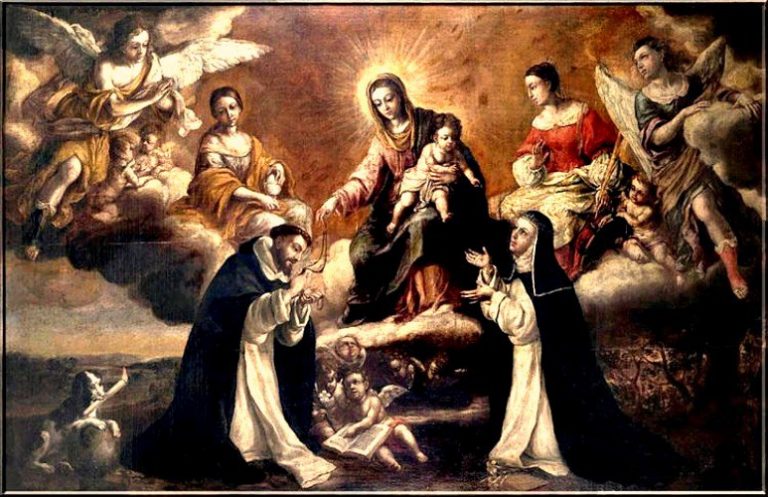By Regis J. Flaherty
Regis J. Flaherty, director of the Gilmary Retreat Center, has over thirty years of experience working with Catholic organizations. He is a bestselling author of several books and a contributor to the wildly popular Faith Basics series.

The most popular private devotion among Catholics may well be the Rosary, which is both a form of prayer and a specific sacramental that aids in prayer.
In saying the Rosary, we call to mind, one at a time, each of the mysteries as a focus of reflection. The series of prayers for each mystery begins with the recitation of the Our Father, followed by ten Hail Marys, ending with the Glory Be. This series is referred to as a decade because of the ten Hail Marys. After completion of the first decade, another mystery is called to mind, and the process of prayer continues.
The Rosary focuses on key aspects of the Christian faith, especially as seen in the twenty mysteries. The Joyful Mysteries are the Annunciation, the Visitation, the Nativity, the Presentation of the Child Jesus, and the Finding of the Child Jesus in the Temple. The Luminous Mysteries comprise Christ’s Baptism, the Wedding at Cana, the Proclamation of the Kingdom, the Transfiguration, and the Institution of the Eucharist. The Sorrowful Mysteries consist of Christ’s Agony in the Garden, the Scourging, the Crowning of Thorns, the Carrying of the Cross, and the Crucifixion. Finally, the Glorious Mysteries include the Resurrection, the Ascension, the Descent of the Holy Spirit, the Assumption of Mary, and the Coronation of Mary.
These meditations have been called a short course in theology because of the wealth of truth and inspiration they contain. Through meditating on these mysteries we are led to prayers of adoration, contrition, thanksgiving, and petition. It is also an opportunity for the Holy Spirit to work in our hearts and minds as we pray to bring understanding and formation.
Where and when the Rosary began is unknown. The use of beads as an aid in prayer has a long history both in the Catholic Church and in other religions. The chain of beads establishes a framework, a setting, a pace for the prayer, and the repetition provides a background for meditation.
Even though the origin of the Rosary is unknown, it is undeniable that its popularity grew significantly through the preaching of Saint Dominic, who died in 1221. Dominic encouraged the Rosary as a remedy to heresy. The meditation on the mysteries developed a foundation of the truths of the faith. This saint also saw the prayer as an antidote to sin. As Dominic and his followers preached throughout Europe, they encouraged the laity to regularly pray the Rosary.
Many popes have also encouraged this devotion. One notable example comes from the reign of Pope Pius V (1566–1572). At that time the Turkish Muslims were actively seeking to conquer Christian Europe and were having significant success in their endeavors. Europe was in real peril.
Pope Pius V asked all the faithful to pray and ask for Mary’s intercession that the Turkish threat would be halted. In particular, Pius encouraged the praying of the Rosary. In the famous Battle of Lepanto on October 7, 1571, the Christian forces defeated the Turkish fleet and effectively ended the threat of conquest by the Muslims.
To acknowledge the effectiveness of praying the Rosary and to thank the Blessed Mother for her intercession, Pius established the Feast of the Holy Rosary to be celebrated each October.
The word rosary comes from the Latin rosarius, which means “garland” or “bouquet of flowers.” It is an apt word for a bouquet of prayers offered to God. The word bead is an Old English term that originally meant “a prayer.”
As with any sacramental, prayer, or devotion, the Rosary can be a tremendous aid in drawing closer to God. However, it can also be misused. The structure and flow of the prayer is meant to aid the individual in meditation. The rhythm of the prayer can quiet the spirit and help a person be more receptive to hearing God, and thus be formed spiritually.
For some, however, the Rosary can become a merely mechanical action, something to be rushed through as a duty. Since the grace of any sacramental is dependent upon the attitude of the person using it, devout and thoughtful use of the Rosary is a prerequisite to enjoying the grace of the devotion.
You Might Also Like

The Bible and the Virgin Mary, part of the St. Paul Center’s Journey Through Scripture series, unveils the mystery of Our Lady that is woven into the fabric of Sacred Scripture. Twelve visually stunning lessons convey the beauty of the doctrine and devotions surrounding Mary, bringing them to life in a powerful, new way.